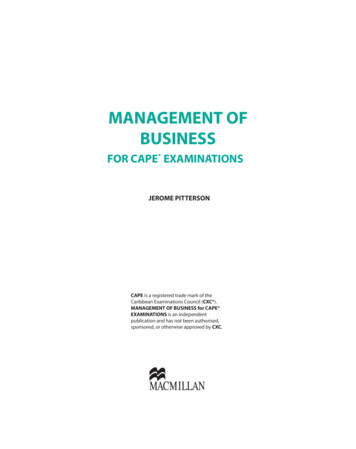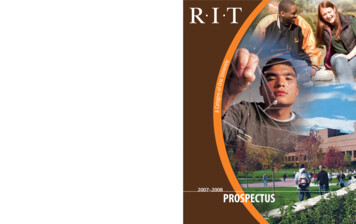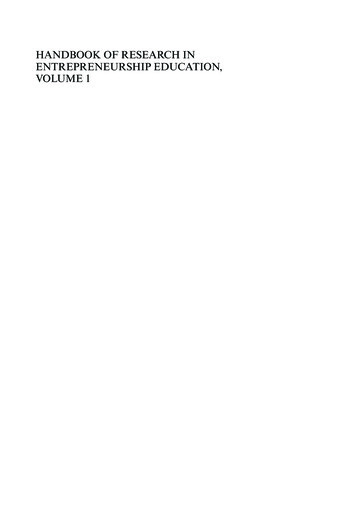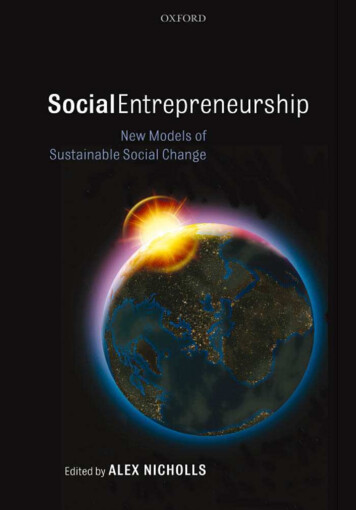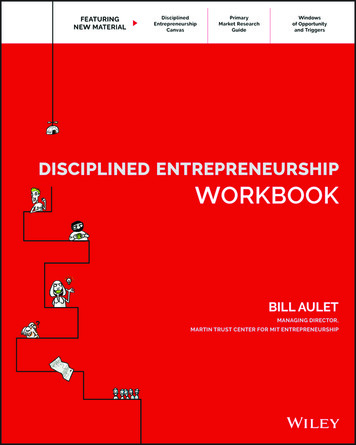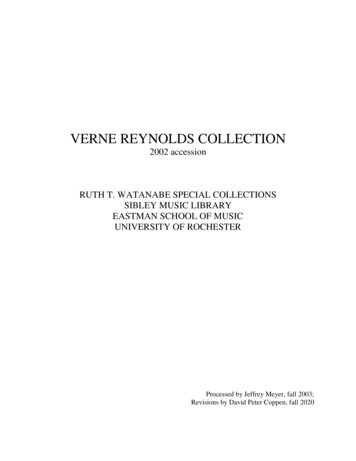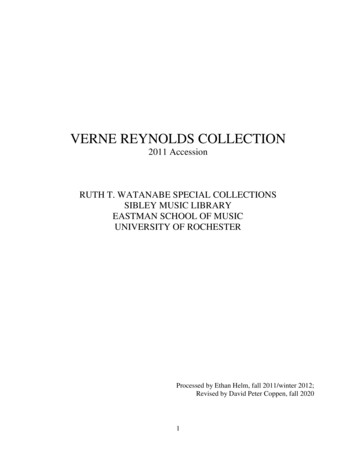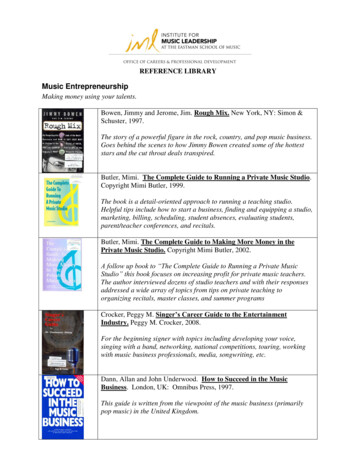
Transcription
REFERENCE LIBRARYMusic EntrepreneurshipMaking money using your talents.Bowen, Jimmy and Jerome, Jim. Rough Mix. New York, NY: Simon &Schuster, 1997.The story of a powerful figure in the rock, country, and pop music business.Goes behind the scenes to how Jimmy Bowen created some of the hotteststars and the cut throat deals transpired.Butler, Mimi. The Complete Guide to Running a Private Music Studio.Copyright Mimi Butler, 1999.The book is a detail-oriented approach to running a teaching studio.Helpful tips include how to start a business, finding and equipping a studio,marketing, billing, scheduling, student absences, evaluating students,parent/teacher conferences, and recitals.Butler, Mimi. The Complete Guide to Making More Money in thePrivate Music Studio. Copyright Mimi Butler, 2002.A follow up book to “The Complete Guide to Running a Private MusicStudio” this book focuses on increasing profit for private music teachers.The author interviewed dozens of studio teachers and with their responsesaddressed a wide array of topics from tips on private teaching toorganizing recitals, master classes, and summer programsCrocker, Peggy M. Singer’s Career Guide to the EntertainmentIndustry. Peggy M. Crocker, 2008.For the beginning signer with topics including developing your voice,singing with a band, networking, national competitions, touring, workingwith music business professionals, media, songwriting, etc.Dann, Allan and John Underwood. How to Succeed in the MusicBusiness. London, UK: Omnibus Press, 1997.This guide is written from the viewpoint of the music business (primarilypop music) in the United Kingdom.
Doan, Gerald R. Establishing School Programs in Chamber Music.Prepared for Chamber Music America Association.This pamphlet is designed for the purpose of beginning or maintaining asuccessful chamber music program in a school setting. It contains tips onprogram administration, recruiting, rehearsing, and budgeting for chambermusic programs.*This book is in the Music Education (K-12) section*Drucker, Peter F. Innovation and Entrepreneurship. New York: HarperBusiness, 1985,First book to present innovation and entrepreneurship as a discipline.Explains what established businesses and new ventures need to know anddo to succeed.Gigante, Beth. A Business Guide for the Music Teacher. San Diego,California: Kjos Music Company, 1987.Guidelines for finding students, creating policies, tuition and makeup,group lessons, projecting a professional image, business & financialpractices, and gathering information about area teachers.Halloran, Mark. The Musician’s Business and Legal Guide. UpperSaddle River, New Jersey: Prentice-Hall, Inc., 1996.Although the majority of this book is geared toward popular musicians, itstill contains plenty of good information for all musicians and composers(especially).Harvard Business Review on Entrepreneurship. Boston: HarvardBusiness School Publishing, 1999.Heflick, David. How to Make Money Performing in Schools. Orient,Washington: Silcox Productions, 1996.The goal of this book is to help performing artists achieve the skillsnecessary to design an effective program for young school audiences. Itdiscusses the needs of the school, ingredients for a successful program,marketing and promotion, and paperwork.
Highstein, Ellen. Making Music in Looking Glass Land: A Guide toSurvival and Business Skills for the Classical Musician, Third Edition.New York: Concert Artists Guild, 1997.This book is aimed directly at emerging, professional-level performers andcomposers. It was written to address the needs of musicians who have beengiven little direction on how to achieve a professional career. It containsreally great tips and resources for the musician who aspires to a career asa soloist or chamber musician.Kotler, Philip and Joanne Scheff. Standing Room Only- Strategies forMarketing the Performing Arts. Boston: Harvard Business School Press,1997.Complete textbook of marketing strategies and techniques for music, dance,opera and theater organizations.Manduca, Elizabeth M. and Alison S. Barr. Successful Studio Teaching.Portland, Maine: The Piano Teacher’s Press, 1993.This book intersperses practical advice with exercises designed forpersonal growth in the areas of image, organization, public relations, andfinance. It also includes templates for documents commonly used in privatestudio teaching.Marks, Lee R. Musicians: Employees or Independent Contractors?.Washington, D.C.: American Symphony Orchestra League, 1991.This legal memorandum discusses the difference between the terms“employee” and “independent contractor” as defined by the IRS withrespect to part-time musicians and part-time orchestras.McGrath, Rita Gunther and Ian MacMillan. The Entrepreneurial Mindset.Boston: Harvard Business School Press, 2000.An overall comprehensive guide to entrepreneurial thinking. Presents a setof practices for capitalizing on uncertainty and rapid change.McManus, Drew. The Adaptistration Compensation Report. UnitedStates: Drew McManus, 2006.Detailed salary data for 74 ICSOM, ROPA, IGSOBM executive directors,music directors, concertmasters, and base musicians.
Newsam, David R. and Barbara Sprague Newsam. Making MoneyTeaching Music. Cincinnati, Ohio: Writer’s Digest Books, 1995.This is the book to read for aspiring music teachers. It covers every aspectof the private studio teacher, and the school (secondary or college) musicteacher. The book discusses important topics such as building a homestudio, student retention, marketing, and relationships with parents ofstudents, and financial advice.Northam, Mark and Lisa Anne Miller. Film and Television Composer’sResource Guide. Milwaukee, Wisconsin: Hal Leonard Corporation, 1997.This book provides information about how to organize and run a filmand/or television music business.Shemel, Sidney and M. William Krasilovsky. This Business of Music.Revised and enlarged 5th edition. New York: Billboard Publications, Inc.,1985.This book is a useful reference tool for musicians, songwriters, agents andmanagers, and record labels. It explains the complexities of contracts,copyrights, royalties, and much more.Spellman, Peter. The Musician’s Internet. Boston, Ma: Berklee Press,2002.Book includes tips on how to expand your on-line presence and gain fans,create a professional web site, share music downloads, sell, and licensemusic on-line, Broadcast on Internet radio, webcast concerts, and streamaudio.Spellman, Peter. The Self-Promoting Musician. Boston, Ma: BerkleePress, 2000.Book for independent musicians, producers, studio owners, or labelsincluding how to write a business plan, create press kits, using the internetfor promotion, how to customize your demos, advice to get music on theradio, and tips of gigging.Tilghman, Romalyn Eisenstark. Audience Development: A PlanningToolbox for Partners. Washington, D.C.: Association of Performing ArtsPresenters, 1994.Practical and helpful, this book presents a step-by-step approach on how todevelop audiences. It includes worksheets and checklists for planning,assessing, budgeting, marketing, and evaluating.
Wallace, David. Reaching Out: A Musician’s Guide to InteractivePerformance. New York: McGraw-Hill High Education, 2008.Explores techniques to connect with and captivate concert audiences.Author David Wallace shares the techniques he has taught at The JuilliardSchool and used for reaching out to any audience regardless ofdemographics and musical expertise and enriching their concert experiencethrough interaction. Featuring real-life examples, concert transcripts, andan Interactive Concert Checklist.Wittry, Diane. Beyond the Baton—What Every Conductor Needs toKnow. New York: Oxford, 2007.A must read for all conducting students! Includes a good section onprogramming.Wold, Thomas. Managing a Nonprofit Organization. New York:Fireside, 1990.Good resource for anyone considering arts administration. Includes infoon what is a nonprofit, boards, marketing, financials, fund raising, andmore.AEC Publication Literature Study: Preparing Young Musicians forProfessional. Utrecht, The Netherlands: Erasmus Thematic Network forMusic.A study of musical development in children.*This book is in the Music Education section*Composers in the Marketplace: How to Earn a Living Writing Music.New York: Meet the Composer, Inc., 1989.This helpful handbook is filled with practical advice on copyright basics,understanding the marketplace, promoting one’s own work, and resourcesof directories, music magazines and service organizations.Contract Issues for Musicians. Rochester, New York: Hiscock & Barclay,LLP., 2007.Best Practices for musicians and the people who work with them. Providesan overview for artists for common terms and concepts in entertainmentlaw.
Management: The Book. Maplewood, New Jersey: New York OperaNewsletter, 1998.This book contains good information on the manager/singer relationship,what to look for in a manager, and how to act as one’s own manager.Contains good information for aspiring opera singers.The MTNA Book of Policies, Letters and Forms. Cincinnati, Ohio:Music Teachers National Association, 1989.This book is a compilation of samples of studio policies, student/parentcorrespondence and student evaluation forms, calendars and miscellaneousadditional materials.Publicity Handbook for Music Teachers. Cincinnati, Ohio: MusicTeachers National Association, 1989.This guide is a small handbook devoted to publicity for private musicteachers.The Singer/Manager Relationship. Washington, D.C.: Opera America,1997.This book is a collection of essays from general directors, artisticadministrators, training program directors, artist managers, conductors,university faculty and singers on the subject of the singer/managerrelationship.
*This book is in the Music Education (K-12) section* Drucker, Peter F. Innovation and Entrepreneurship. New York: Harper Business, 1985, First book to present innovation and entrepreneurship as a discipline. Explains what established businesses and new ventures need to know and do to succee

